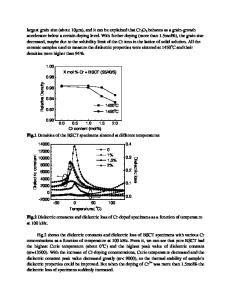Improved Dielectric Properties of Heterostructured Ba 0.5 Sr 0.5 TiO 3 Thin Film Composites for Microwave Dielectric Dev
- PDF / 125,848 Bytes
- 6 Pages / 612 x 792 pts (letter) Page_size
- 43 Downloads / 364 Views
U17.4.1
Improved Dielectric Properties of Heterostructured Ba0.5 Sr0.5 TiO3 Thin Film Composites for Microwave Dielectric Devices M. Jain1, S.B. Majumder1, R.S. Katiyar1, A.S. Bhalla2, D.C. Agrawal3, F.W Van Keuls4, F.A. Miranda5, R.R. Romanofsky5, C.H. Mueller6 1 Department of Physics, University of Puerto Rico, San Juan, PR-00931, USA 2 Materials Research Center, Pennsylvania State University, University Park, PA 16802, USA 3 Materials Science Program, Indian Institute of Technology, Kanpur, U.P., India 4 Ohio Aerospace Institute, Cleveland, OH 44142, USA 5 NASA, Glenn Research Center, Cleveland, OH 44135, USA 6 Analex Corporation, Cleveland, OH-44135, USA
ABSTRACT In the present work we have deposited MgO and Ba0.5Sr0.5TiO3 (BST50) thin layers in different sequences to make MgO:BST50 hetero-structured thin films. These films were characterized by X-ray diffraction and found to be highly (100) textured. The figure of merit {(C0-Cv)/(C0.tanδ)} of the hetero-structured films was found to be higher as compared to pure BST50 films measured at 1 MHz frequency with electric field of 25.3 kV/cm. These films were used to make eight element coupled micro-strip phase shifter and characterized in a frequency range of 13-15 GHz. The high frequency figure of merit (κ factor, defined as the ratio of degree of phase shift per dB loss) measured at around 14 GHz with electric field of 333 kV/cm has been markedly improved (around 64.28 o/dB for hetero-structured film as compared to 24.65 o/dB for pure film). Improvement in dielectric properties in a wide frequency range in the MgO:BST are believed to be due to the higher densification of the hetero-structured films.
INTRODUCTION With the rapid growth of various communication systems, the demand for tunable circuits at RF and microwave frequencies has increased. Barium strontium titanate (BST) is a promising material for applications in microwave devices, which include varactors, phase shifters, tunable filters etc [1-4]. For these applications, it is desirable to produce thin films with optimum combination of tunability {(C0-Cv)/C0, where C0 and Cv are the capacitance at zero and bias fields respectively} and loss tangents (tanδ). Tunability of a ferroelectric in general is maximum near its Curie-point. Hence the compositions of BST which have Curie-point around room temperature is desired for the devices operating at room temperature. Numerous studies on the dielectric properties of BST based ceramics have been carried out [5]. However, the large dielectric constants and high control voltages limit the use of bulk BST at microwave frequencies. In bulk, many researchers have used the BST composite structures by adding low loss and low relative dielectric constant (εr) dielectrics to suppress the dielectric constant and dielectric losses of BST for microwave applications [6-9]. Bulk composites of ferroelectric BST
U17.4.2
and low loss non-ferroelectric MgO (tanδ~10-5) have been reported to show reduced dielectric constant and dielectric loss compared to pure BST [9]. To reduce
Data Loading...











